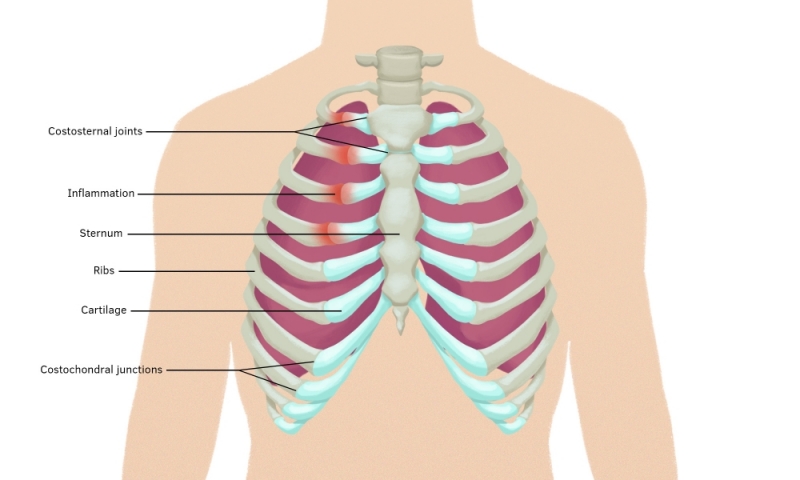
Costochondritis is usually known as chest wall pain. It is an inflammation of the junctions joining the upper ribs and the cartilage holding them to the breastbone. The condition often results in pain in the chest, generally localized. The patient can often reproduce this chest pain by pushing on the cartilage in the front of their ribcage. The condition is usually harmless and recovery happens without treatment, in a majority of the cases. Hire an experienced and professional physiotherapist to cure costochondritis treatment in Gurgaon from PAL Physiotherapy one of best physiotherapy center located at sector 56, Gurgaon.
The exact cause of the disorder is debatable however speculations suggest that it happens due to an increased activity of the arms.
The pain associated with the disorder can be mild or excruciatingly severe. Mild cases may only cause your When the chest of the patient feels tender to touch or some pain is experienced when they push on the area of their chest cartilage, the case is of mild pain.
In some cases, excruciating pain shooting down the limbs or extremely annoying chest pain disturbing your daily life is experienced. Such cases are severe cases of costochondritis. The pain doesn’t seem to go away in such cases. The condition starts showing signs of recovery within a few weeks. In case it doesn’t, the patient may require treatment.
Another condition called ‘Tietze Syndrome’ is an inflammatory process causing a visible enlargement of the costochondral junction. The condition causes severe pain on coughing and deep breathing. This is not a life threatening or contagious disorder. However, it is fastidious and quite painful.
Costochondritis and Tietze's syndrome are often considered similar to each other. People generally get confused between the two but the two are very different conditions.
No cause of costochondritis has been identified as such. However, the following reasons have been speculated for the disorder -
Some of the most common symptoms of people with costochondritis are -
Sometimes, these symptoms can also be an indicator of other dangerous medical conditions, including a heart attack. Hence, proper medical attention for the diagnosis of this disorder is recommended.
The diagnosis of costochondritis often starts with the doctor performing a physical examination before making a diagnosis. The patient may be asked about their symptoms, their medical history and their family’s medical history.
As the physical exam begins, the doctor generally examines the level of pain by manipulating the patient’s rib cage. Any signs of infection or inflammation, if present, will also be diagnosed.
In case the symptoms are confusing enough, the doctor might perform some tests of the sort of X-rays and blood tests, to eliminate any other conditions that may be causing these symptoms. The patient may also need an electrocardiogram (ECG or EKG) or an X Ray of the chest to make sure that they are not suffering from any coronary artery disease or another heart condition.
Costochondritis can effectively be treated using physical therapy. This may even include Ultrasonic Therapy, Class 4 Laser Therapy,and TENS, with or without nerve stimulation. Physical therapists usually design personalized treatment plans as per the symptoms of the patient. These may include Manual therapy, electrical stimulation, hot or cold therapy, ultrasound, and Deep Breathing exercises. The aim is to relieve musculoskeletal chest pain, deep breathing without pain, and achieving a full range of motion.
Treatment for costochondritis in Gurgaon may sometimes involve the use of nonsteroidal anti-inflammatory drugs (NSAIDs) such as ibuprofen or other pain relieving medicines by your doctor. The doctor may instruct you to enforce some permanent changes in your lifestyle in case you suffer from persistent or chronic costochondritis. Your doctor may also recommend complete bed rest, physical therapy along with cold or heat therapy using a heating pad and ice.
The patient's response to the treatment is timely evaluated during the process. Subjecting them to various levels of pain is often the way. The doctor may also perform a procedure called transcutaneous electrical nerve stimulation (TENS). This involves the use of small amounts of electricity to stop your nerves from sending signals of pain or aching to your brain.
The patient is often advised to minimize the activities provoking the symptoms of costochondritis. For instance, reducing the frequency and intensity of exercise or work activities is suggested by physical therapists. Using medicines to suppress cough is also recommended by doctors to alleviate the symptoms.
A course of trigger point therapy is also quite helpful to reduce the pain, in addition to the above methods. It is usually treated in a conservative fashion, however medications may sometimes be administered.
